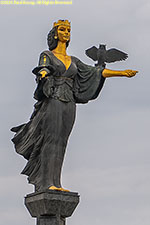
Sofia is the capital and largest city in Bulgaria. It lies in the Sofia Valley at the foot of Vitosha Mountain in the western part of the country. In antiquity, it was known as Serdica and has been inhabited since at leasr 7000 BCE. There are 49 thermal or mineral springs in Sofia.
St. Sofia (Hagia Sofia), patron of the city, sculpture by Georgi Chapkanov.
A martenitsa is a small piece of adornment made of white and red wool yarn, usually in the form of two dolls, a whie male (Pizho) and a red female (Penda). Martenitsi are given as gifts and worn from Baba Marta Day (March first) until the wearer first sees a stork, a swallow, or a blossoming tree, or until the end of March. Then the martenitsa is tied to a fruit tree.
National Assembly Building
The Bulgarian Academy of Sciences was established in 1869.
National Archeological Museum of the Bulgarian Academy of Sciences
The Institute of Ethnology and Folkloric Studies and the Ethnographic Museum of the Bulgarian Academy of Sciences is housed in an ornate palace.
Largo, a combination of three Socialist Classicism buildings in Central Sofia, was built in the 1950s. The Council of Ministries is on the left, the former communist party headquarters in the center, and the Presidency is on the right.
The Presidential Palace of the Republic of Bulgaria was built in 1954-56. The honor guard are dressed in ceremonial uniforms from the 19th century.
Former royal palace, now the National Art Gallery
Archeological site of the western gate of Ancient Serdica, 4th century.
Ivan Vazov National Theater
Regional History Museum of Sofia
Catholic Cathedral of Sofia, St. Joseph Parish, rebuilt on its old location in 2006 after being destroyed by Allied bombing raids during WW II.
Dated from the early 4th century, the Church of St. George is the oldest standing edifice in Sofia.
Medieval Bulgarian Orthodox church of St. Petka Samardzhiyska (St. Petka of the Saddlers)
St. Nedelya Orthodox Cathedral dates back to the 10th century and was rebuilt in 1856, then renovated in 1898. After a bomb attack in 1925, it was restored in 1927 and again inaugurated in 1933.
Cathedral Saint Alexander Nevsky, built in the Neo-Byzantine style, is the cathedral church of the Patriarch of Bulgaria and one of the 100 largest Christian churches in the world and the largest cathedral in the Balkans.
Russian Church of St. Nicolas the Miracle-Worker
The St. Sofia Basilica was built in the eastern necropolis of Serdica. More than fifty tombs from the 3rd to the 5th centuries are preserved in its foundations. Four churches were successively built on the site, each one atop the previous one. The top one dates from the 6th century. The adjacent monument of the unknown soldiers, in front of the church's southern wall, has an eternal flame in front of five stone funerary urns from all over the country.
Boyana Church, officially the Church of Saint Nicholas and Saint Panteleimon, a Unesco World heritage Site, is a medieval Bulgarian Orthodox Church. The east wing was built in the 10th or 11th century, the central wing was added in the 13th century, and the western expansion was built in the 19th century. Photography is not allowed inside and visitors are only allowed inside for ten minutes. The church has magnificent frescoes. Some of the earliest frescoes were painted in 1259 and are considered predecessors of the European Renaissance. The first (eastern) section of the church is a small single-apse cruciform building from the late 10th-early 11th century. The second section of the church with Saint Nicholas of Myrna as patron was appended in 1259 and is a two-story tomb church. The third, Renaissance part of the church, dedicated to Saint Panteleimon, was built in the mid-19th century.
Sofia's National History Museum, established in 1973, is Bulgaria's largest museum. It covers the period from the Paleolithic Age to the proclamation of Bulgaria as a People's Republic in 1946.
Regional costumes
We were particularly interested in the Thracian treasures. The Early Hellenistic Panagyurishte gold treasure, late 4th-early 3rd century BCE, was discovered in 1949.
The Banya Bashi Mosque, a Sunni mosque built over thermal spas during the 16th century Ottoman Empire, is the only functioning mosque in Sofia.
The Central Synagogue of Sofia, built in 1909, a Romaniote Orthodox Jewish congregation with an octagonal dome, is the largest synagogue in southeast Europe and the third largest in Europe. It is one of only two active synagogues remaining in Bulgaria.
Restaurant Hadjidraganovite Kashti serves traditional Bulgarian cuisine and has folk music.
©2025 Mermaid Underwater Photographic. All Rights Reserved.
This page sponsored by Mermaid Underwater Photographic. Contact us at mermaid@underwater.org.
Last modified 3 October 2025